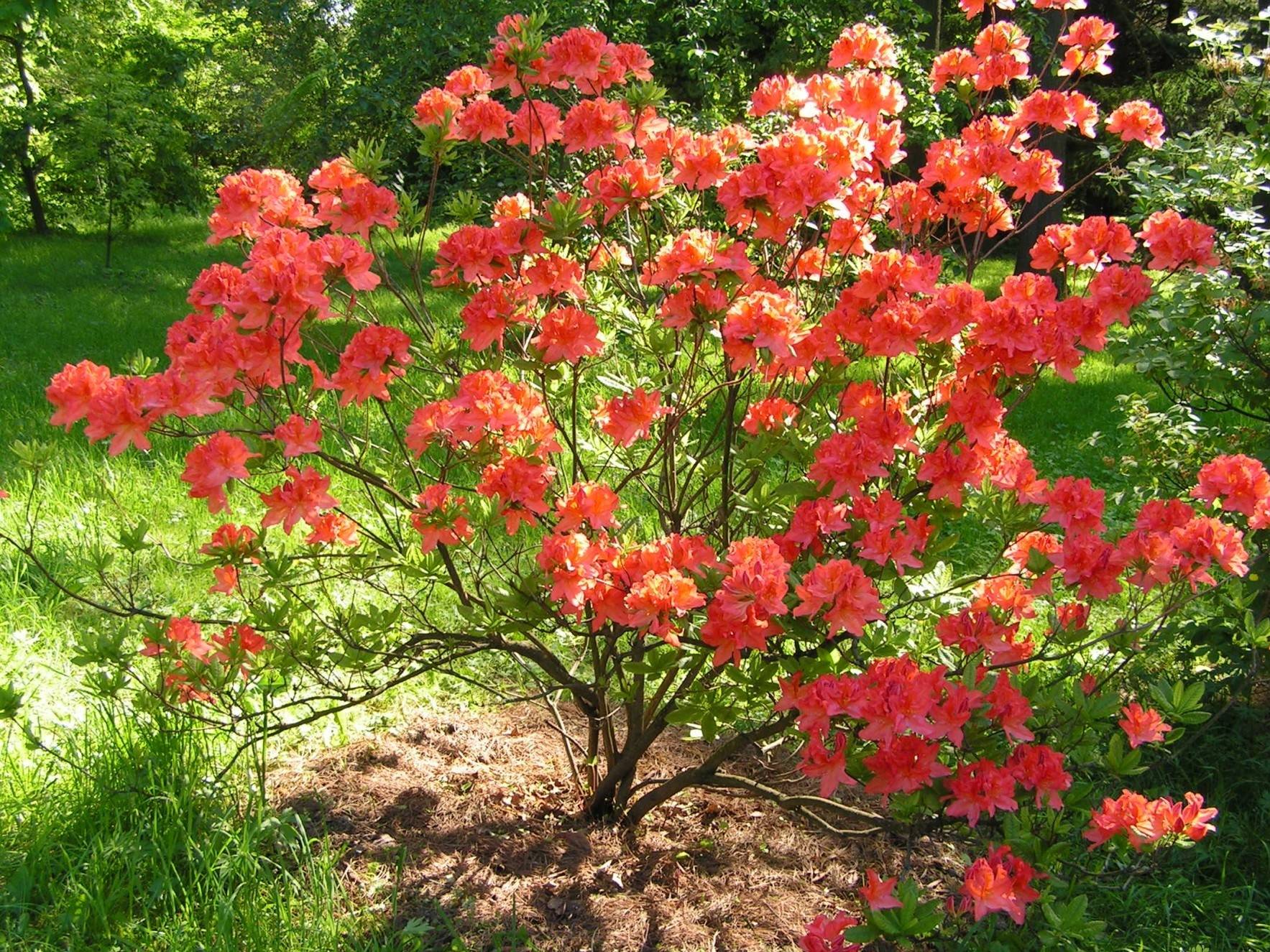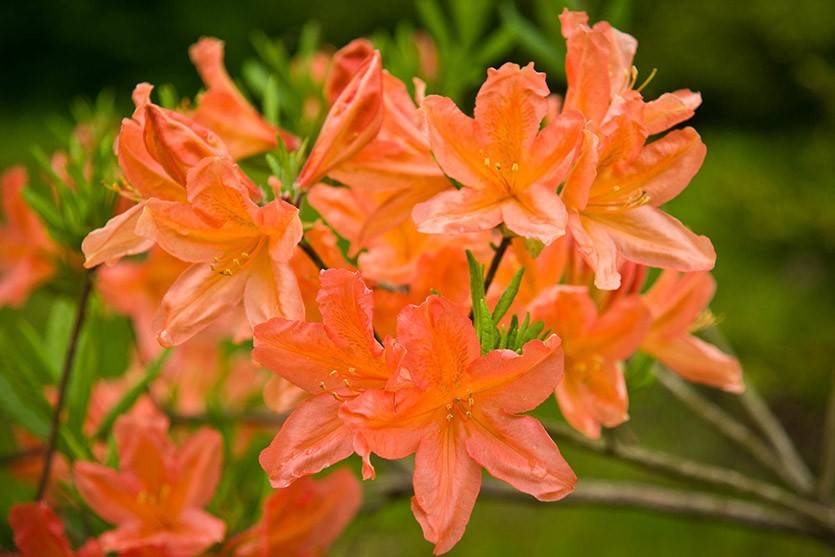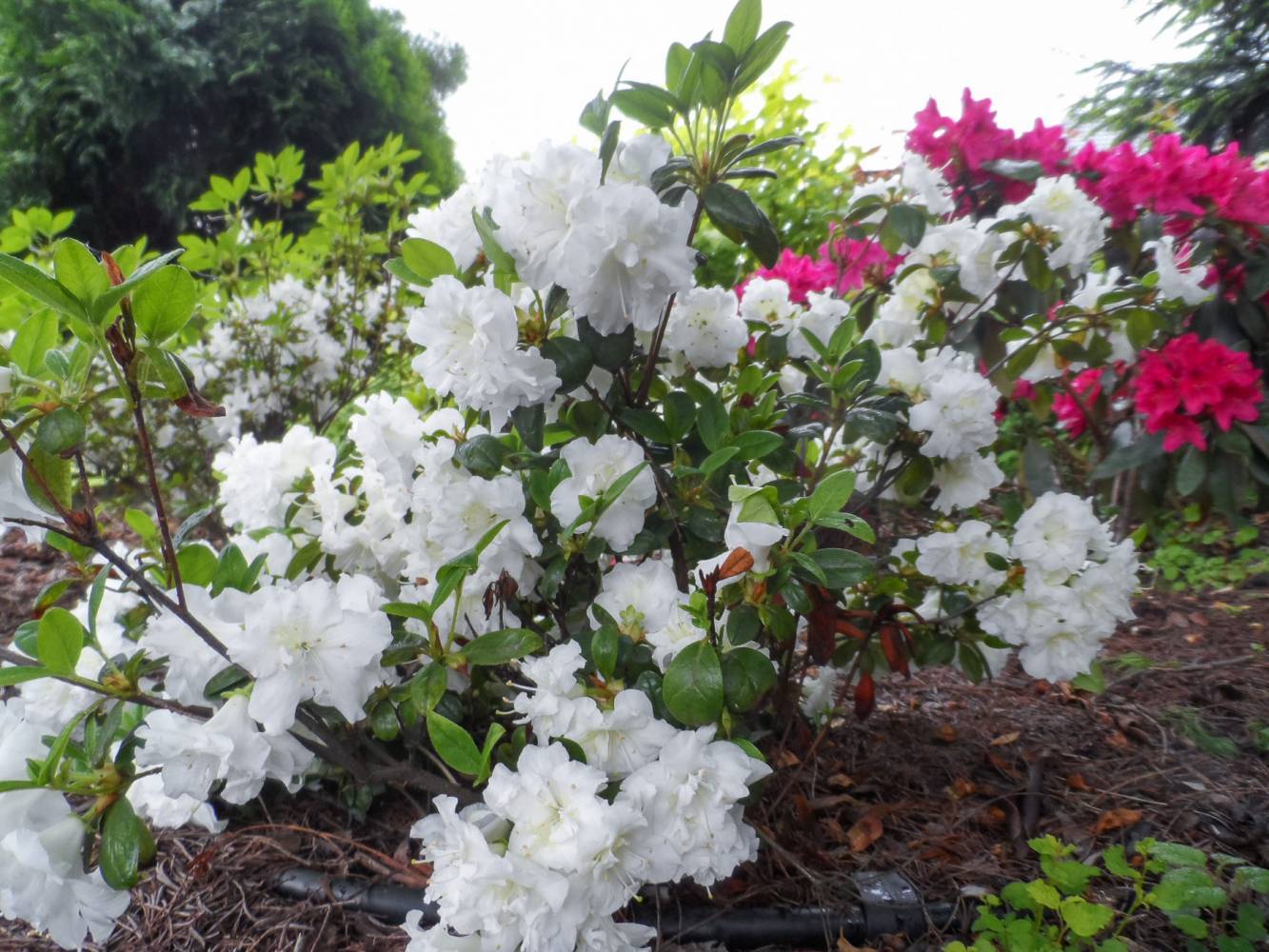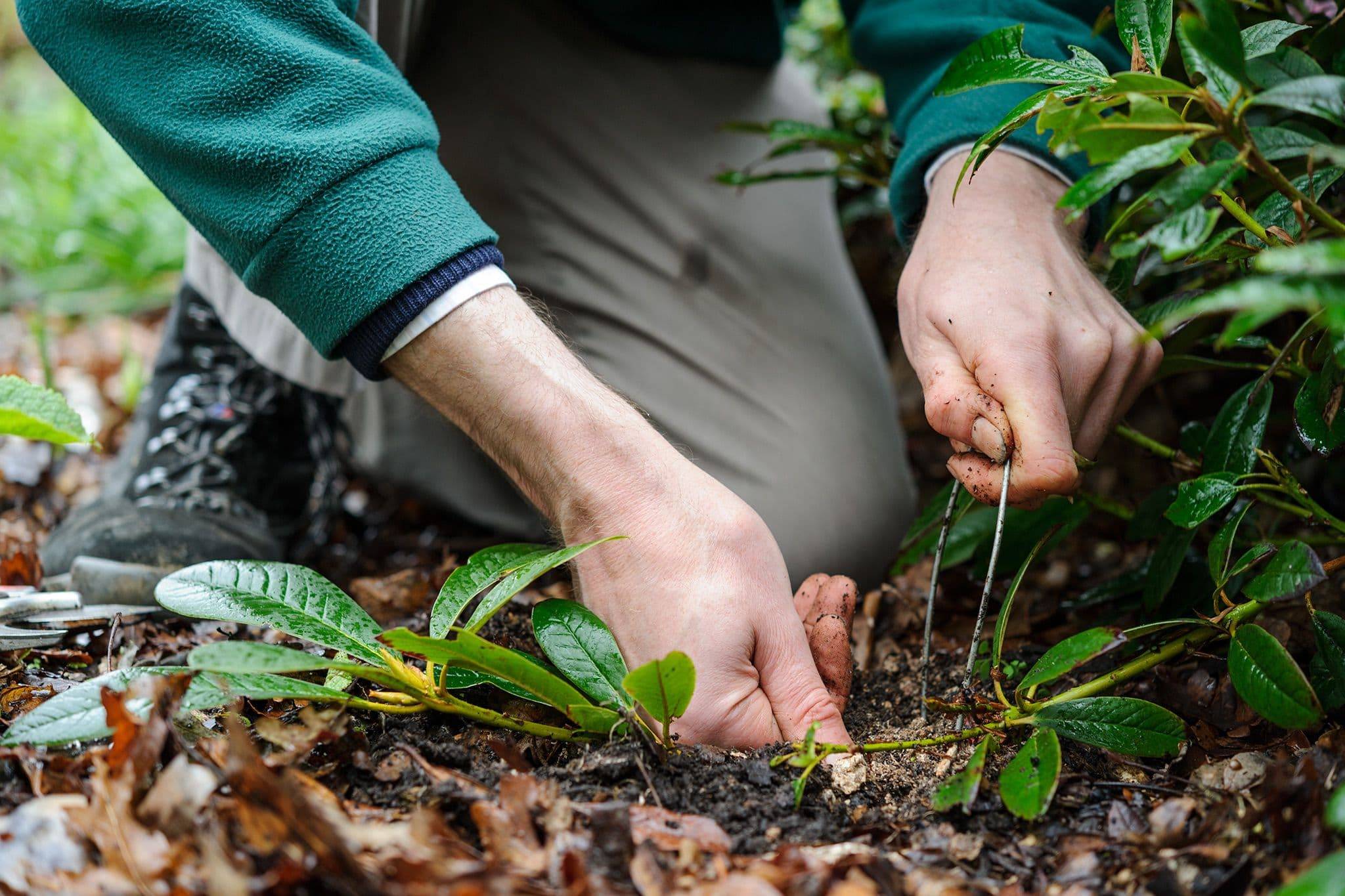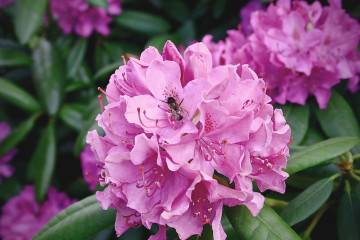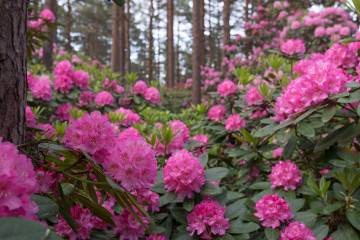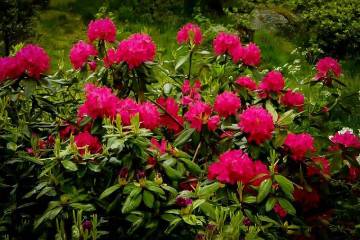Japanese salmon rhododendron
Content:
Beautiful, with buds of different colors, Japanese rhododendron will be a great addition to any garden. This variety will not cause problems, since it is quite unpretentious. Even an amateur gardener can plant it in his country house, and the plant will delight the eye with its interesting appearance for many years.
History of appearance
The Japanese rhododendron belongs to the azalea species. These are very ancient flowers, they appeared on the planet more than 50 million years ago and grew in almost every point of the globe. But as a result of the ice age, its habitats were destroyed.
According to most sources, the plant is native to northern and central Japan. Due to the fact that the homeland of the bush is rich in open areas, wild varieties are not found in the forests.
England is considered to be another homeland of the plant. In the 15th century. the traveler from Holland Brainius brought samples of the bush to the country, but they did not take root there. Subsequently, another researcher tried to bring the bush, but it wilted on the way. Only at the beginning of the 19th century. the captain of an English ship brought a blooming azalea from India to London. As a result of a very long selection work, many different hybrids and varieties were obtained from this bush.
In addition to flowering varieties, deciduous hybrids were also bred. For this, wild ornamental bushes were brought from the East and the USA. The domestication of rhododendrons was carried out throughout Europe, as a result of which about 12 thousand species of azalea were obtained.
Description of the plant
Under natural conditions, the alpine rose is a bush that reaches about 2 m in height. The ornamental plant does not have such dimensions. This is due primarily to age. Wild azalea has been growing for 80 years, artificially created species - about 50 years.
In Korean national cuisine, rhododendron is often used: the traditional national dish chintale hwajong is prepared from it, and the plant petals are added to the filling of rice cakes.
Popular varieties of Japanese rhododendron
The classic color of the Japanese plant is orange, but there are also varieties with other bright colors. The following varieties have gained the greatest popularity in Russia.
Rhododendron deciduous Japanese salmon
Not only bright and lush inflorescences have become a characteristic feature of this variety. Its high winter hardiness allows it to be grown not only in the Central lane, but also in the Moscow region. This type can be identified by some characteristics:
- the bush can reach a height of 2 m;
- blooming flowers can be 7 cm in diameter, they are collected in inflorescences from 6 to 12 pcs. and have a soft salmon shade;
- flowering lasts about 3 weeks from mid or late May, depending on climatic conditions;
- leaves of green color and elongated shape can be up to 12 cm long;
- the bark is light gray.
To plant such a variety on the site, you need to purchase seedlings 2-4 years old. So that the delicate buds of the plant do not burn, salmon rhododendron is planted in a place where the sun is not located all day. Best planted next to a fence. Although this variety loves moisture, it only needs to be fed a couple of times a year.
Japanese cream rhododendron
The delicate creamy color of the petals goes well with the yellow heart of the flower. A distinctive feature of this variety is the intolerance of the neighborhood with large-sized flowers and trees, but it will feel comfortable on lawns. It is often used when creating landscaping, as creamy rhododendron grows well in areas with large elevation differences.
The height of the bush can be from 1.2 to 2 m. It grows in one place with proper care for about 40 years. Flowers are collected in lush inflorescences of 6-12 pcs. so that foliage is practically not visible behind them.
Japanese Rhododendron Schneeperle
This variety is one of the earliest. It begins to bloom in mid-March and finishes in late spring. Due to its snow-white flowers, the plant is often used in the design of festive bouquets.
The bush is quite unpretentious, but it grows very slowly. By the age of 10, it can reach a height of only 35 cm. In the design of the garden, it is mainly used to create natural borders. A feature of the plant is the need for formative pruning of the shrub after flowering. Thanks to this action, the flower has an incentive to form new buds for the next year.
Application in landscape design
Due to its unpretentiousness and bright flowering, the Japanese rhododendron is widely used in landscape design.
To find the right application, you need to know the height, shape and size of the leaves, the size and color of the flowers, and the length of the flowering period. You should also know how each particular variety tolerates different weather conditions.
Many experts recommend planting rhododendrons in groups with other trees and flowers to provide a scenic view of the site.
How to plant a Japanese rhododendron
Since the seedlings are bought in nurseries where the necessary conditions have been created for them, the plant must undergo acclimatization before being transplanted into open ground. To do this, the container with a young bush is hardened, taking it out into the fresh air in a semi-shaded place, first for half an hour, then the duration increases. After 10 days, the flower is transplanted into a previously prepared hole.
Selection and preparation of a site for planting
It is recommended to plant rhododendron bushes in a place where the sun appears only at the beginning or end of the day. It is best to plant a bush next to a fence or building façade. If you plant in an open area, then the leaves and flowers of the plant may die from burns.
For planting azaleas, a special soil is prepared, mixed with mulch and clean river sand. Clayy and heavy soil types can kill the plant. Peat or pine needles can be used as additives.
Reproduction
Japanese rhododendron can be propagated in several ways: cuttings, layering and dividing old bushes.
When grafting in the spring, a 15 cm branch is cut off and several lower leaves are removed from it. The stalk is placed in moist soil, in which it will remain for 2-3 months before rooting.If the root system has developed well enough, then in August you can transplant it into open ground. Otherwise, it is better to postpone planting until next year, and move the container with cuttings to a bright room with a temperature of 8-12 ° C.
With a large number of branches at the bush, reproduction can be performed by division. To do this, the bush is dug up and a sharp shovel is divided into several separate parts with its roots and shoots.
The easiest way is to propagate by layering. A healthy branch is selected and bent to the ground. The place of the fold is sprinkled with soil. The young plant separates in the fall or spring.
Care: how to properly water and fertilize
The Japanese rhododendron is very sensitive to drought. If there is an artificial reservoir in the garden, it is better to plant bushes next to it. If this is not possible, then in the warm season, the rhododendron needs regular watering. So that the soil does not dry out, it is mulched when moistened and sprinkled with needles.
Alpine rose practically does not need additional feeding. Most often, it is enough to add a special combined mixture once a year. Also, several times in the summer, the soil around the trunk is sprinkled with peat or needles.
Diseases and pests
Japanese rhododendrons can develop various fungal diseases if the roots are not adequately aerated. For prophylaxis, the bushes should be treated with a solution of Bordeaux liquid.
Root rot can occur when the soil is not acidic enough. You can increase the acidity of the earth by introducing peat or needles into it.
The Japanese rhododendron can be attacked by local pests. Treating the plant with insecticides will help get rid of them.
Many gardeners grow various varieties of Japanese rhododendron. Due to its ease of care and beautiful flowering, it took its place in the summer cottages of the inhabitants of Russia. All he needs is proper care and the necessary soil for growth.
